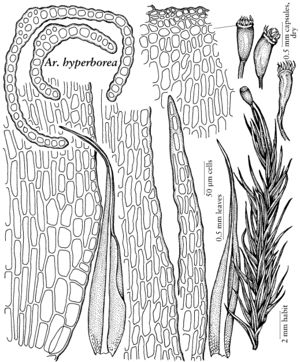Difference between revisions of "Arctoa hyperborea"
Bryol. Europ. 1: 157. 1846,.
imported>Volume Importer |
imported>Volume Importer |
||
| Line 59: | Line 59: | ||
|publication year= | |publication year= | ||
|special status= | |special status= | ||
| − | |source xml=https:// | + | |source xml=https://bitbucket.org/aafc-mbb/fna-data-curation/src/2e0870ddd59836b60bcf96646a41e87ea5a5943a/coarse_grained_fna_xml/V27/V27_508.xml |
|genus=Arctoa | |genus=Arctoa | ||
|species=Arctoa hyperborea | |species=Arctoa hyperborea | ||
Latest revision as of 21:26, 5 November 2020
Plants in compact, dark green tufts. Stems 1–3(–5) cm. Leaves erect-spreading, lanceolate, subulate, 2–3 mm; costa 30–55 µm wide at base, short-excurrent, rough near tip; distal laminal cells mostly subquadrate (1–2:1), incrassate; basal laminal cells elongate, alar cells differentiated, quadrate or slightly enlarged. Seta 4–6(–8) mm. Capsule exserted, slightly curved, obscurely to distinctly ribbed when dry, annulus developed, separating; peristome large, not spreading outward when dry. Spores 18–30 µm.
Phenology: Capsules mature summer.
Habitat: Siliceous rock or soil
Elevation: high-alpine elevations
Distribution
Greenland, Europe.
Discussion
Arctoa hyperborea is a rare arctic-alpine moss found on rock ledges or crevices at high elevations. It is distinguished from other species of the genus by its short-excurrent costa, shorter seta (the length is highly variable), and peristome not spreading when dry.
Selected References
None.
